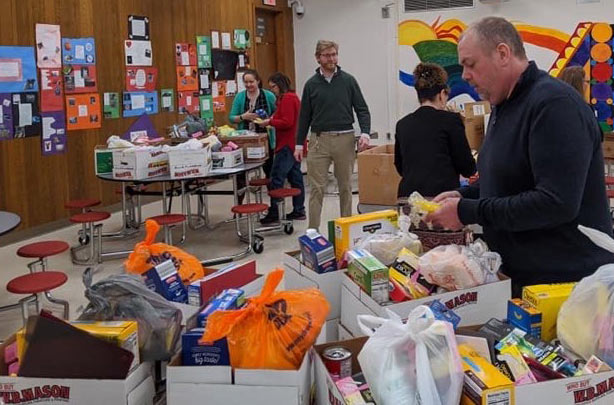As schools across the state get a crash course in remote learning, educators are valiantly trying to do their best to “be there” for their students — meeting students’ social-emotional needs while attempting to provide some normalcy through academics.
Take a peek inside the Mohawk Valley home of teachers Michael and Mindy Pavone and you’ll see Mindy giving her art students a tutorial with a laptop perched atop her sectional sofa. The Clinton High School art teacher holds “office hours” on a video conferencing platform to answer questions about student art projects — but is also there to offer reassuring words as her students try to cope with the anxiety and uncertainty swirling around their lives right now.
Michael, a Spanish teacher and vice president of the Morrisville-Eaton Faculty Association, has prepared a wide range of activities for his five levels of middle and high school students. In the first day or two of the school shutdown, he was basically trying to check in with his students, to see who could connect online, review and turn in work — even if it’s just a photo taken on a cellphone.
In his rural district, internet is not reliable and many students do not have devices. As a member of the district’s technology committee, he was frustrated that while his district submitted its application for Smart Schools Bond Act funding long ago, it was only approved by the State Education Department a few weeks before schools were closed. He’s not sure how soon the laptops and tablets selected two years ago to give every child in the district a device will arrive.
This new NYSUT Fact Sheet provides guidance on important considerations in addressing New York State’s continuity of learning requirement for local leaders and members.
Aside from their work with their students, Michael and Mindy are also juggling care for their own children, a fourth grader and a pre-kindergartner. “I’m so proud of my fellow teachers — they have stepped up in amazing ways,” Michael Pavone said. He noted how much his son has enjoyed touching base with his teacher. “His class was videoconferencing and using filters … It was nothing but giggles and laughter. It got rowdy, but a good rowdy.”
Pavone has also been touched by his colleagues’ commitment to making sure needy families in the community have food and other supplies. Morrisville-Eaton FA members emptied their school’s food pantry, headed by social studies teacher Meaghan Palmer, to pack boxes which included food basics and other essential supplies like toothpaste and feminine hygiene items. Volunteers have also been making sandwiches and assembling breakfast and lunch bags for needy students. “Our plan is to keep delivering school work packets, as well as food and annual Easter meal baskets,” Pavone said. “This has all really underscored the social justice mission of our union.”

Morrisville-Eaton FA President James McCarthy and other members scrambled the week before the school closures to sort food and other supplies to distribute care packages to needy families. Photo provided.
Around the state, media accounts and social channels have highlighted similar efforts by educators in districts large and small. Educators are reading stories to their students on YouTube, touching base via video conferencing; and leading enrichment activities from nature walks to exercise sessions.
“This is the hardest I’ve ever worked,” White Plains elementary teacher Ann Hovis-Williams told a local television station as she and other members talked about how they’re reaching out to their students.
NYSUT Executive Vice President Jolene DiBrango said the tremendous outreach work by so many of our members has been heartening, but the situation has also highlighted the fact that students may not have access to the internet or they may be unable to engage with educators for a variety of reasons.
“The digital divide is real,” DiBrango said. “There are also so many social-emotional needs: Fear and uncertainty about the novel coronavirus, sick family members or fear of becoming ill, food insecurities, loss of employment, and other factors associated with this unprecedented event can be overwhelming, especially for our youngest and our most vulnerable students.”
To help members in this uncharted territory, NYSUT has prepared a fact sheet, “Continuity of Learning Guidance for Educators during the COVID-19 Pandemic,” with tips and other important information. It notes that members should be aware of their district’s “Continuity of Education” plan submitted to the State Education Department.
It is up to local districts to determine academic expectations, including instructional decisions, the use of a variety of methods, access to tools and learning management systems, technological resources and curriculum adaptability.
Teachers considering online learning must make sure that any technology used is approved by the district, the fact sheet notes. To ensure privacy, the establishment of student accounts to access online resources should be approved by the district data protection officer. With remote teaching and communication, educators must exercise caution before sending sensitive information through email such as student names, parent names address information and other personally identifiable information.
“As educators, we need to be aware of evolving physical, social and emotional demands of our students while trying to stay connected with them in new ways,” DiBrango said. “We need to think about the whole child and look to social and emotional and trauma-informed practices to help now and when school reopens.”